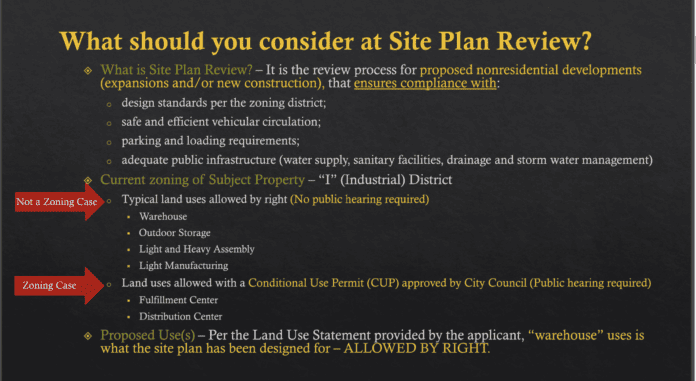Chad McCurdy shared his thoughts on Facebook to explain why the Cedar Hill Council voted the way they did at Tuesday’s Council meeting.
How does it work? Ownership & land use? Zoning? Site plan approval? Building permits?
The issue of zoning was front and center this week as we reviewed a site plan for a new warehouse on Mt. Lebanon at Cedar Hill Rd. We had a room full of concerned citizens from the nearby Cedar Crest neighborhood and Cedar Hill Rd. that did not want the warehouses. They asked us to vote to stop the warehouses, change the zoning, delay the project, etc. Ultimately the council made the best decision we could given our available options. Hopefully, this information will help.
The majority of the time, ownership, land use, and zoning go hand in hand. This is what happened Tuesday night. The state of Texas believes that the rights of the land owner trumps all other considerations. The only influence that a city has over land use is through the use of zoning. If a city has zoned a property for a specific use, whether it is residential, retail, or in this case industrial, there are a list of project types allowed by that zoning. The term for this usage is ALLOWED BY RIGHT.
If a property owner proposes a development/construction project that is ALLOWED BY RIGHT (permitted by the designated zoning) the only determination to be made by the city is whether the proposal meets codes and restrictions. State law says that the city cannot stop a project that is in agreement with the zoning for a property. We can try to gain agreement/consensus for additional restrictions or accommodations, but we cannot stop the project.
What about changing the zoning?
The zoning on a property can be changed under a couple of conditions. If the property owner applies for a zoning change the city will hold public hearings. This is done by posting the public notice and followed by a hearing before the Planning and Zoning commission, followed by City Council. What we were presented with in Case No. SP-570-2023 was a site plan for the current zoning, not a zoning change. Had the zoning on the property been retail, residential, or even agriculture, and they wanted to change it to industrial we would have had more options. A zoning change can be denied.
However, the state of Texas also says that our zoning cannot be arbitrary. This means the the city cannot change zoning on a property because we don’t like a project. Further we cannot stop a project that is allowed by the zoning without significant cause, and that bar is high. The city does have the ability to change zoning, but not because we don’t like a project. Zoning changes must either be applied for by the property owner, or done as part of a comprehensive plan.
In 2019 we went through a comprehensive plan review. There were residents that lived in the neighborhood that were part of the city wide committee to make recommendations. At that time there were no recommendations to change the zoning along Mt. Lebanon or Cedar Hill, Rd. That is when the zoning could have been changed. Changing the zoning after someone has made application because you don’t like their project will only buy the city a lawsuit that the city is going to lose. In that case the city out $500,000 or more in legal fees, plus damages, and the court will order the city to permit the project.
If you have vacant land near your home you might want to take a look at our zoning map, link below. There’s a link to a copy of the comprehensive plan here as well.
Zoning Map
https://www.cedarhilltx.com/…/ZONING-MAP—October-2022-
Cedar Hill NEXT Comprehensive plan
https://www.cedarhilltx.com/
One final thing I should address. This questions wasn’t asked but I think it would be helpful for everyone to know.
Why was the plan denied by Planning and Zoning but allowed with restrictions by City Council?
The Planning and Zoning Commission has a basic charge and that is to determine if a project meets zoning requirements, governing codes, and ordinances. That being all of our published rules that would govern this project on that property. It was determined that the planning department was requiring the site to be designed so that tractor/trailer traffic be routed in a specific pattern.
It was also determined that the screening for the site was insufficient. There were a few other things, but those were the primary reasons given for denying the site plan by Planning and Zoning. The denial doesn’t mean you cannot build the project, the plan was denied because it was determined to be incomplete/inadequate.
When the project came to Council we could have taken the same steps and denied the project as being incomplete/inadequate. If the project were denied it would have defaulted to a legal process, but it would still move forward. The developer would have 15 days to respond to the list of deficiencies. They would provide a list of how they intend to modify their plan to meet just the basic published codes, and ordinances. Then the city has 15 days to respond with whether the remedies are sufficient. If the remedies are sufficient, by law, the developer can obtain their building permit. If the city does not respond within 15 days, by law, the developer can obtain their building permit. Let me remind you that is after we denied the project. The case would never come back before the Planning & Zoning Commission, or City Council because there wouldn’t be time to review the responses and get it on our agenda.
Mind you we cannot stop the project anyway; we are only determining if it meets zoning, codes & ordinances. This process is actually easier on the developer. It was put in place H.B. 3167.
By approving the site plan with restrictions we took the project outside of the timed process. We gave city staff an opportunity to oversee the final site plan design, and we obtained some additional considerations for the neighborhood(s) impacted by the project. The developer agreed to add a sidewalk on the opposite side of the street. They agreed to plant larger caliper trees to provide more screening sooner. They agreed to having all truck traffic route through the Mt. Lebanon exit. They agreed to removing the drive access from the tractor/trailer parking to Cedar Hill Rd. They agreed to placing of the dumpsters behind the buildings not visible from Cedar Hill Rd. And they agreed to park land dedication for future hike/bike trail development.
This was not the choice we wanted to make but it was the best choice available given our options.











